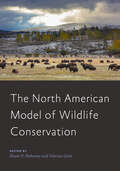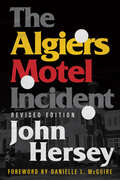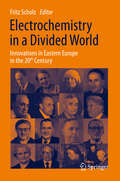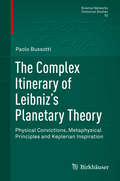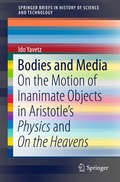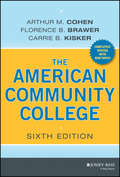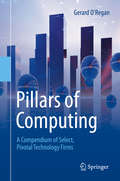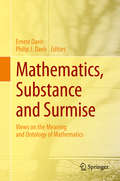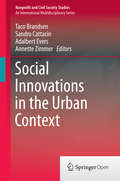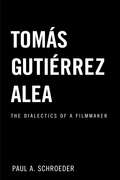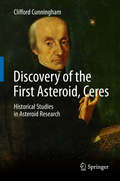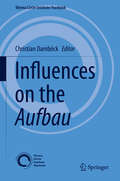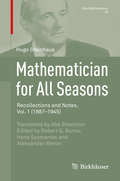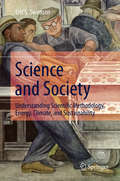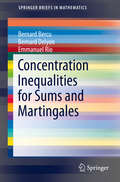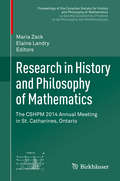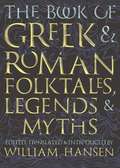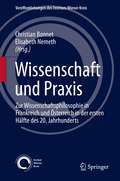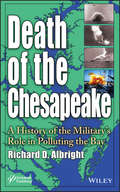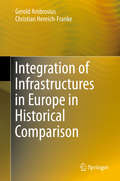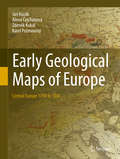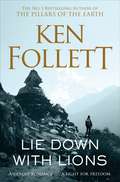- Table View
- List View
The North American Model of Wildlife Conservation (Wildlife Management and Conservation)
by Shane P. Mahoney Valerius GeistAt the end of the nineteenth century, North America suffered a catastrophic loss of wildlife driven by unbridled resource extraction, market hunting, and unrelenting subsistence killing. This crisis led powerful political forces in the United States and Canada to collaborate in the hopes of reversing the process, not merely halting the extinctions but returning wildlife to abundance. While there was great understanding of how to manage wildlife in Europe, where wildlife management was an old, mature profession, Continental methods depended on social values often unacceptable to North Americans. Even Canada, a loyal colony of England, abandoned wildlife management as practiced in the mother country and joined forces with like-minded Americans to develop a revolutionary system of wildlife conservation. In time, and surviving the close scrutiny and hard ongoing debate of open, democratic societies, this series of conservation practices became known as the North American Model of Wildlife Conservation.In this book, editors Shane P. Mahoney and Valerius Geist, both leading authorities on the North American Model, bring together their expert colleagues to provide a comprehensive overview of the origins, achievements, and shortcomings of this highly successful conservation approach. This volume• reviews the emergence of conservation in late nineteenth–early twentieth century North America• provides detailed explorations of the Model's institutions, principles, laws, and policies• places the Model within ecological, cultural, and socioeconomic contexts• describes the many economic, social, and cultural benefits of wildlife restoration and management• addresses the Model's challenges and limitations while pointing to emerging opportunities for increasing inclusivity and optimizing implementationStudying the North American experience offers insight into how institutionalizing policies and laws while incentivizing citizen engagement can result in a resilient framework for conservation. Written for wildlife professionals, researchers, and students, this book explores the factors that helped fashion an enduring conservation system, one that has not only rescued, recovered, and sustainably utilized wildlife for over a century, but that has also advanced a significant economic driver and a greater scientific understanding of wildlife ecology.Contributors: Leonard A. Brennan, Rosie Cooney, James L. Cummins, Kathryn Frens, Valerius Geist, James R. Heffelfinger, David G. Hewitt, Paul R. Krausman, Shane P. Mahoney, John F. Organ, James Peek, William Porter, John Sandlos, James A. Schaefer
The Algiers Motel Incident
by John HerseyOn the evening of July 25, 1967, on the third night of the 12th Street Riot, Detroit police raided the Algiers Motel. Acting on a report of gunfire, officers rounded up the occupants of the motel's annex—several black men and two white women—and proceeded to beat them and repeatedly threaten to kill them. By the end of the night, three of the men were dead. Three police officers and a private security guard were tried for their deaths; none were convicted. In The Algiers Motel Incident, first published in 1968, Pulitzer Prize–winning author John Hersey strings together interviews, police reports, court testimony, and news stories to recount the terrible events of that night. The result is chaotic and sometimes confusing; facts remain elusive. But, Hersey concludes, the truth is clear: three young black men were murdered "for being, all in all, black young men and part of the black rage of the time."With a new foreword by award-winning author Danielle L. McGuire, The Algiers Motel Incident is a powerful indictment of racism and the US justice system.
The Algiers Motel Incident
by John HerseyOn the evening of July 25, 1967, on the third night of the 12th Street Riot, Detroit police raided the Algiers Motel. Acting on a report of gunfire, officers rounded up the occupants of the motel's annex—several black men and two white women—and proceeded to beat them and repeatedly threaten to kill them. By the end of the night, three of the men were dead. Three police officers and a private security guard were tried for their deaths; none were convicted. In The Algiers Motel Incident, first published in 1968, Pulitzer Prize–winning author John Hersey strings together interviews, police reports, court testimony, and news stories to recount the terrible events of that night. The result is chaotic and sometimes confusing; facts remain elusive. But, Hersey concludes, the truth is clear: three young black men were murdered "for being, all in all, black young men and part of the black rage of the time."With a new foreword by award-winning author Danielle L. McGuire, The Algiers Motel Incident is a powerful indictment of racism and the US justice system.
Electrochemistry in a Divided World: Innovations in Eastern Europe in the 20th Century
by Fritz ScholzIn this collection of interrelated essays, the authors review landmark developments in electrochemistry building on biographic material and personal insight. The book facilitates understanding of the innate pathways of developments in electrochemical science as a result of lucky circumstances fitting to objective conditions. Thus the book will help to understand the present state of electrochemistry and offer inspiration for solving today’s scientific challenges. The authors as experienced electrochemists from the U.S., Western and Eastern Europe also provide guidance for scientific careers by presenting biographical examples of famous electrochemists.
The Complex Itinerary of Leibniz’s Planetary Theory: Physical Convictions, Metaphysical Principles and Keplerian Inspiration (Science Networks. Historical Studies #52)
by Paolo BussottiThis book presents new insights into Leibniz’s research on planetary theory and his system of pre-established harmony. Although some aspects of this theory have been explored in the literature, others are less well known. In particular, the book offers new contributions on the connection between the planetary theory and the theory of gravitation. It also provides an in-depth discussion of Kepler’s influence on Leibniz’s planetary theory and more generally, on Leibniz’s concept of pre-established harmony. Three initial chapters presenting the mathematical and physical details of Leibniz’s works provide a frame of reference. The book then goes on to discuss research on Leibniz’s conception of gravity and the connection between Leibniz and Kepler.
Bodies and Media: On the Motion of Inanimate Objects in Aristotle’s Physics and On the Heavens (SpringerBriefs in History of Science and Technology)
by Ido YavetzThis book presents a recasting of Aristotle’s theory of spatial displacement of inanimate objects. Aristotle’s claim that projectiles are actively carried by the media through which they move (such as air or water) is well known and has drawn the attention of commentators from ancient to modern times. What is lacking, however, is a systematic investigation of the consequences of his suggestion that the medium always acts as the direct instrument of locomotion, be it natural or forced, while original movers (e.g. stone throwers, catapults, bowstrings) act indirectly by impressing moving force into the medium. Filling this gap and guided by discussions in Aristotle’s Physics and On the Heavens, the present volume shows that Aristotle’s active medium enables his theory - in which force is proportional to speed - to account for a large class of phenomena that Newtonian dynamics - in which force is proportional to acceleration - accounts for through the concept of inertia. By applying Aristotle’s medium dynamics to projectile flight and to collisions that involve reversal of motion, the book provides detailed examples of the efficacy and coherence that the active medium gives to Aristotle’s discussions. The book is directed primarily to historians of ancient, medieval, and early modern science, to philosophers of science and to students of Aristotle’s natural philosophy.
The American Community College
by Arthur M. Cohen Florence B. Brawer Carrie B. KiskerPraise for the Previous Edition of The American Community College "Projecting the future for the community colleges of the early twenty-first century involves projecting the future for the nation in general: its demographics, economy, and public attitudes.... At heart is a discourse on how the institutions may adapt historical structures and practices to a changing world, and how those changes may ultimately affect students, the community, and society at large." —from the Conclusion, "Toward the Future" "Since 1982, The American Community College by Cohen and Brawer has been the authoritative book on community colleges. Anyone who wants to understand these complex and dynamic institutions—how they are evolving, the contributions they make, the challenges they face, the students they serve, and the faculty and leaders who deliver the services and the curricula—will find The American Community College both essential reading and an important reference book." —George R. Boggs, former president and CEO, American Association of Community Colleges "I have been a community college president for over forty-one years and a graduate professor for three decades. This book has been an inspiration to generations of students, faculty members, and administrators. It has become the classic of the field because it has great 'take-home' value to us all." —Joseph N. Hankin, president, Westchester Community College "Cohen and Brawer's classic work is the touchstone for a comprehensive overview of the American community college. This is a seminal book for graduate students as well as seasoned professionals for understanding this uniquely American institution." —Charles R. Dassance, former president, Central Florida Community College
Pillars of Computing: A Compendium of Select, Pivotal Technology Firms
by Gerard O'ReganThis accessible compendium examines a collection of significant technology firms that have helped to shape the field of computing and its impact on society. Each company is introduced with a brief account of its history, followed by a concise account of its key contributions. The selection covers a diverse range of historical and contemporary organizations from pioneers of e-commerce to influential social media companies. Features: presents information on early computer manufacturers; reviews important mainframe and minicomputer companies; examines the contributions to the field of semiconductors made by certain companies; describes companies that have been active in developing home and personal computers; surveys notable research centers; discusses the impact of telecommunications companies and those involved in the area of enterprise software and business computing; considers the achievements of e-commerce companies; provides a review of social media companies.
Mathematics, Substance and Surmise: Views on the Meaning and Ontology of Mathematics
by Ernest Davis Philip J. DavisThe seventeen thought-provoking and engaging essays in this collection present readers with a wide range of diverse perspectives on the ontology of mathematics. The essays address such questions as: What kind of things are mathematical objects? What kinds of assertions do mathematical statements make? How do people think and speak about mathematics? How does society use mathematics? How have our answers to these questions changed over the last two millennia, and how might they change again in the future? The authors include mathematicians, philosophers, computer scientists, cognitive psychologists, sociologists, educators and mathematical historians; each brings their own expertise and insights to the discussion. Contributors to this volume:Jeremy AvigadJody AzzouniDavid H. BaileyDavid BerlinskiJonathan M. BorweinErnest DavisPhilip J. DavisDonald GilliesJeremy GrayJesper LützenUrsula MartinKay O’HalloranAlison PeaseSteven PiantadosiLance RipsMicah T. RossNathalie SinclairJohn StillwellHellen Verran
Social Innovations in the Urban Context (Nonprofit and Civil Society Studies)
by Taco Brandsen Sandro Cattacin Adalbert Evers Annette ZimmerThis book addresses the practice of social innovation, which is currently very much in the public eye. New ideas and approaches are needed to tackle the severe and wicked problems with which contemporary societies are struggling. Especially in times of economic crisis, social innovation is regarded as one of the crucial elements needed to move forward. Our knowledge of its dynamics has significantly progressed, thanks to an abundance of studies on social innovation both general and sector-specific. However, despite the valuable research conducted over the past years, the systematic analysis of social innovation is still contested and incomplete. The questions asked in the book will be the following: 1. What is the nature of social innovations? 2.What patterns can be identified in social innovations emerging at the local level? 3.How is the emergence and spread of social innovations related to urban governance? More precisely, which conditions and arrangements facilitate and hinders social innovation? We explore these questions using different types of data and methods, and studying different contexts. In particular, we focus on innovations that aim at solving problems of the young unemployed, single parents and migrants. This analysis is based on original research carried out in the period 2010-2013 in the framework of a European project with a specific empirical research strategy. Research was carried out in 20 cities in 10 different European countries.
Tomas Gutierrez Alea: The Dialectics of a Filmmaker
by Paul A. SchroederFirst Published in 2003. Routledge is an imprint of Taylor & Francis, an informa company.
Tomas Gutierrez Alea: The Dialectics of a Filmmaker
by Paul A. SchroederFirst Published in 2003. Routledge is an imprint of Taylor & Francis, an informa company.
Discovery of the First Asteroid, Ceres: Historical Studies in Asteroid Research
by Clifford CunninghamBased on extensive primary sources, many never previously translated into English, this is the definitive account of the origins of Ceres as it went from being classified as a new planet to reclassification as the first of a previously unknown group of celestial objects. Cunningham opens this critical moment of astronomical discovery to full modern analysis for the first time. This book includes all the voluminous correspondence, translated into English, between the astronomers of Europe about the startling discovery of Ceres by Piazzi in 1801. It covers the period up to March 1802, at which time Pallas was discovered. Also included are Piazzi’s two monographs about Ceres, and the sections of two books dealing with Ceres, one by Johann Bode, the other by Johann Schroeter. The origin of the word ‘asteroid’ is explained, along with several chapters on the antecedents of the story going back to ancient Greek times. The formulation of Bode’s Law is given, as are the details on the efforts of Baron von Zach to organize a search for the supposed missing planet between Mars and Jupiter. Examples of verse created to commemorate the great discovery are included in this first volume. The author, who has a PhD in the History of Astronomy, is a dedicated scholar of the story of asteroids and his research on the discovery of Ceres is comprehensive and fully sourced. The discovery came at a time when rival astronomers were in hot competition with each other, and when the true nature of these celestial bodies was not yet known. With astronomers in France, Italy and beyond vying to understand and receive credit for the new class of astral bodies, drama was not in short supply--nor were scientific advances.
Influences on the Aufbau (Vienna Circle Institute Yearbook #18)
by Christian DamböckThis volume offers 11 papers that cover the wide spectrum of influences on Rudolf Carnap’s seminal work, Der Logische Aufbau der Welt (The Logical Structure of the World). Along the way, it covers a host of topics related to this important philosophical work, including logic, theories of order, science, hermeneutics, and mathematics in the Aufbau, as the work is commonly termed. The book uncovers the influences of such neglected figures as Gerhards, Driesch, Ziehen, and Ostwald. It also presents new evidence on influences of well-known figures in philosophy, including Husserl, Rickert, Schlick, and Neurath. In addition, the book offers comparisons of the Aufbau with the work of contemporary scientists such as Weyl and Wiener as well as features new archival findings on the early Carnap.This book will appeal to researchers and students with an interest in the history and philosophy of science, history of analytic philosophy, the philosophy of the Vienna Circle, and the philosophy in interwar Germany and Austria.
Mathematician for All Seasons: Recollections and Notes Vol. 1 (1887-1945) (Vita Mathematica #18)
by Hugo SteinhausThis book presents, in his own words, the life of Hugo Steinhaus (1887–1972), noted Polish mathematician of Jewish background, educator, and mathematical popularizer. A student of Hilbert, a pioneer of the foundations of probability and game theory, and a contributor to the development of functional analysis, he was one of those instrumental to the extraordinary flowering of Polish mathematics before and after World War I. In particular, it was he who “discovered” the great Stefan Banach. Exhibiting his great integrity and wit, Steinhaus’s personal story of the turbulent times he survived – including two world wars and life postwar under the Soviet heel – cannot but be of consuming interest. His account of the years spent evading Nazi terror is especially moving. The steadfast honesty and natural dignity he maintained while pursuing a life of demanding scientific and intellectual enquiry in the face of encroaching calamity and chaos show him to be truly a mathematician for all seasons.The present work will be of great interest not only to mathematicians wanting to learn some of the details of the mathematical blossoming that occurred in Poland in the first half of the 20th century, but also to anyone wishing to read a first-hand account of the history of those unquiet times in Europe – and indeed world-wide – by someone of uncommon intelligence and forthrightness situated near an eye of the storm.
Science and Society: Understanding Scientific Methodology, Energy, Climate, and Sustainability
by Eric S. SwansonThis undergraduate textbook educates non-science majors—our future policy makers—on how science works, the rules that underpin our existence, our impact on nature, and nature's impact on us. The book provides a concise, historically based, non-mathematical treatment of modern physics relevant to societal issues. It challenges readers to examine the problems we face (and their own beliefs) in light of the scientific method.With a narrative structure, Science and Society explains the scientific process and the power it brings to dealing with the natural world. The reader will gain a deeper understanding of scientific results reported by the media, and thus the tools to develop a rational, fact-based assessment of energy and resource policy.Praise for Science and Society:"Anyone who thinks society can be managed without science should think again, or better: read this book. Eric Swanson explains how science permeates society, and with simple examples of the scientific process he shows its special power in dealing with the natural world. This is a must read for the world's seven billion scientists."F.E. Close, OBE, Oxford University, author of, among others, "Half-Life: The Divided Life of Bruno Pontecorvo, Physicist or Spy", "The Infinity Puzzle", and "Neutrino"
Concentration Inequalities for Sums and Martingales (SpringerBriefs in Mathematics)
by Bernard Bercu Bernard Delyon Emmanuel RioThe purpose of this book is to provide an overview of historical and recent results on concentration inequalities for sums of independent random variables and for martingales.The first chapter is devoted to classical asymptotic results in probability such as the strong law of large numbers and the central limit theorem. Our goal is to show that it is really interesting to make use of concentration inequalities for sums and martingales.The second chapter deals with classical concentration inequalities for sums of independent random variables such as the famous Hoeffding, Bennett, Bernstein and Talagrand inequalities. Further results and improvements are also provided such as the missing factors in those inequalities.The third chapter concerns concentration inequalities for martingales such as Azuma-Hoeffding, Freedman and De la Pena inequalities. Several extensions are also provided.The fourth chapter is devoted to applications of concentration inequalities in probability and statistics.
Research in History and Philosophy of Mathematics: The CSHPM 2014 Annual Meeting in St. Catharines, Ontario (Proceedings of the Canadian Society for History and Philosophy of Mathematics/ Société canadienne d’histoire et de philosophie des mathématiques)
by Maria Zack Elaine LandryThis volume contains thirteen papers that were presented at the 2014 Annual Meeting of the Canadian Society for History and Philosophy of Mathematics/La Société Canadienne d’Histoire et de Philosophie des Mathématiques, held on the campus of Brock University in St. Catharines, Ontario, Canada. It contains rigorously reviewed modern scholarship on general topics in the history and philosophy of mathematics, as well as on the meeting’s special topic, Early Scientific Computation. These papers cover subjects such as •Physical tools used by mathematicians in the seventeenth century •The first historical appearance of the game-theoretical concept of mixed-strategy equilibrium •George Washington’s mathematical cyphering books •The development of the Venn diagram •The role of Euler and other mathematicians in the development of algebraic analysis •Arthur Cayley and Alfred Kempe’s influence on Charles Peirce's diagrammatic logic •The influence publishers had on the development of mathematical pedagogy in the nineteenth century •A description of the 1924 International Mathematical Congress held in Toronto, told in the form of a “narrated slide show” Written by leading scholars in the field, these papers will be accessible to not only mathematicians and students of the history and philosophy of mathematics, but also anyone with a general interest in mathematics.
The Book of Greek and Roman Folktales, Legends, and Myths
by William HansenThe first anthology ever to present the entire range of ancient Greek and Roman stories—from myths and fairy tales to jokesCaptured centaurs and satyrs, talking animals, people who suddenly change sex, men who give birth, the temporarily insane and the permanently thick-witted, delicate sensualists, incompetent seers, a woman who remembers too much, a man who cannot laugh—these are just some of the colorful characters who feature in the unforgettable stories that ancient Greeks and Romans told in their daily lives. Together they created an incredibly rich body of popular oral stories that include, but range well beyond, mythology—from heroic legends, fairy tales, and fables to ghost stories, urban legends, and jokes. This unique anthology presents the largest collection of these tales ever assembled. Featuring nearly four hundred stories in authoritative and highly readable translations, this is the first book to offer a representative selection of the entire range of traditional classical storytelling.Set mostly in the world of humans, not gods, these stories focus on figures such as lovers, tricksters, philosophers, merchants, rulers, athletes, artists, and soldiers. The narratives range from the well-known—for example, Cupid and Psyche, Diogenes and his lantern, and the tortoise and the hare—to lesser-known tales that deserve wider attention. Entertaining and fascinating, they offer a unique window into the fantasies, anxieties, humor, and passions of the people who told them.Complete with beautiful illustrations by Glynnis Fawkes, a comprehensive introduction, notes, and more, this one-of-a-kind anthology will delight general readers as well as students of classics, fairy tales, and folklore.
The Book of Greek and Roman Folktales, Legends, and Myths
by William HansenThe first anthology ever to present the entire range of ancient Greek and Roman stories—from myths and fairy tales to jokesCaptured centaurs and satyrs, talking animals, people who suddenly change sex, men who give birth, the temporarily insane and the permanently thick-witted, delicate sensualists, incompetent seers, a woman who remembers too much, a man who cannot laugh—these are just some of the colorful characters who feature in the unforgettable stories that ancient Greeks and Romans told in their daily lives. Together they created an incredibly rich body of popular oral stories that include, but range well beyond, mythology—from heroic legends, fairy tales, and fables to ghost stories, urban legends, and jokes. This unique anthology presents the largest collection of these tales ever assembled. Featuring nearly four hundred stories in authoritative and highly readable translations, this is the first book to offer a representative selection of the entire range of traditional classical storytelling.Set mostly in the world of humans, not gods, these stories focus on figures such as lovers, tricksters, philosophers, merchants, rulers, athletes, artists, and soldiers. The narratives range from the well-known—for example, Cupid and Psyche, Diogenes and his lantern, and the tortoise and the hare—to lesser-known tales that deserve wider attention. Entertaining and fascinating, they offer a unique window into the fantasies, anxieties, humor, and passions of the people who told them.Complete with beautiful illustrations by Glynnis Fawkes, a comprehensive introduction, notes, and more, this one-of-a-kind anthology will delight general readers as well as students of classics, fairy tales, and folklore.
Wissenschaft und Praxis: Zur Wissenschaftsphilosophie in Frankreich und Österreich in der ersten Hälfte des 20. Jahrhunderts (Veröffentlichungen des Instituts Wiener Kreis #22)
by Christian Bonnet Elisabeth NemethDie Wissenschaftsphilosophie des frühen 20. Jahrhunderts ist reichhaltiger und differenzierter in ihren Standpunkten als lange vermutet. Die Autoren zeigen das anhand der nur teilweise erforschten Interaktion zwischen den Wissenschaftsphilosophen des deutschen und französischen Sprachraums. Das Buch liefert neue Erkenntnisse zur Rolle der Philosophiekongresse in Prag 1934 und Paris 1937 sowie zur Bedeutung einzelner Akteure wie Marcel Boll, der die Rezeption des Logischen Empirismus in Frankreich beförderte. Die Spuren, die Ernst Mach, aber auch der weniger bekannte deutsche Physiologe und Hirnforscher Ewald Hering in der französischen Wissenschaftsphilosophie hinterließen, verfolgen die Autoren bis hin zu den Ideen Jean Piagets. Im Mittelpunkt des Buchs stehen Philosophen aus Frankreich, Deutschland und Österreich und ihre Leistung, die Wissenschaften nicht nur erkenntnistheoretisch und logisch durchleuchtet, sondern auch erkannt zu haben, dass ihre theoretische Struktur nur dann vollständig erfasst werden kann, wenn ihre praktische Dimension mit einbezogen wird. Dafür steht Henri Poincaré, der die tragende Rolle der Konventionen für die Theoriebildung in der Mathematik herausstellte. Sichtbar wird der Bezug zur Praxis auch in Moritz Schlicks Überlegungen zu einer auf Empirie basierenden Ethik oder in der Arbeit Otto Neuraths, der eine aus den modernen Wissenschaften gewonnene Konzeption menschlichen Erkennens für das Projekt der gesellschaftlichen Aufklärung fruchtbar machen wollte.
Death of the Chesapeake: A History of the Military's Role in Polluting the Bay
by Richard AlbrightIn essence this book deals with an area that contributes significantly to the pollution and degradation of Chesapeake Bay, but has been completely overlooked in many of the efforts to restore the Bay, specifically, the federal military pollution sources. The book also recognizes for the first time, that efforts to restore the Bay have failed because of violation of a fundamental precept of environmental cleanup; that is, to sample the site and see what is there. The Bay itself has never been sampled. Thus this book presents a view of the environmental condition of Chesapeake Bay that is totally unique. It covers a part of the history of the Bay that is not widely known, including how the Bay was formed. It presents a mixture of science, military history, and novel solutions to the Bay's degradation. In so doing, the author examines the military use of the Bay and reveals the extent of munitions dumpsites containing nitrogen and phosphorus as well as chemical warfare material, and how this is effecting the environment. The book concludes with the author's own clean-up plan that, if implemented, would go a long way to restoring health to Bay. The book is supplemented with many photographs and maps.
Integration of Infrastructures in Europe in Historical Comparison
by Gerold Ambrosius Christian Henrich-FrankeThis book compares the cross-border integration of infrastructures in Europe such as post, telecommunication and transportation in the 19th century and the period following the Second World War. In addition to providing a unique perspective on the development of cross-border infrastructures and the international regimes regulating them, it offers the first systematic comparison of a variety of infrastructure sectors, identifies general developmental trends and supplies theoretical explanations. In this regard, integration is defined as international standardization, network building and the establishment of international organizations to regulate cross-border infrastructures.
Early Geological Maps of Europe: Central Europe 1750 to 1840
by Jan Kozák Alena Čejchanová Zdeněk Kukal Karel PošmournýThis book focuses on the presentation and evaluation of geological maps of the Central Europe from 1750 up to 1840. Milestones in presentation of stratigraphy and tectonics and new geological models on such maps will be underlined. Map descriptions contain fundamentals editorial data as well as the map author’s affiliation and biographies. It represents for the region of the Central Europe the first work of this type. Geological maps represent geological synthesis and indicate the level of geological knowledge throughout history. They serve as guidelines for an economic utilization of mineral deposits and further geological investigation.
Lie Down With Lions
by Ken FollettLie Down With Lions is the thrilling tale of suspense and deceit from master of the spy story, Ken Follett.A Dangerous RomanceIn Paris, rival spies Ellis and Jean-Pierre both fall in love with Jane, and all three become gripped in a tangled web of lust and deception as they battle terrorist conspiracies. Ultimately Jane can marry only one and chooses Jean-Pierre.A Fight for FreedomIn Afghanistan the Mujahedeen are fighting to free their country of the Soviet invasion and the newlyweds travel to the Valley of the Five Lions to help the cause as doctors. Fierce fighting means they must find a way out of the line of fire. A Perilous EscapeHelp unexpectedly comes in the form of her husband’s nemesis, Ellis, and knowing both men have dangerous secrets, Jane must once again choose who to trust if she is to make her escape over one of the most remote mountain ranges in the world . . .
